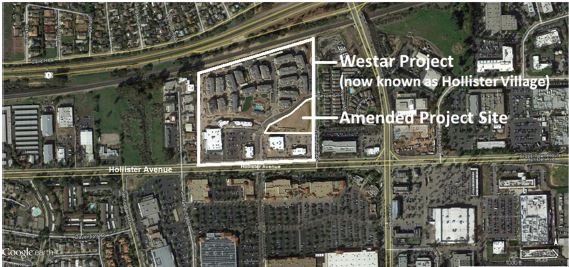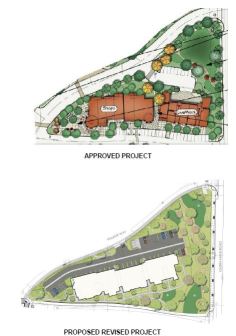Another Piece of Westar Nears Approval
Hollister Village 27-Unit 'Triangle' Property Passes Planning Commission
The last piece of the Westar Hollister Village complex came close to dropping into place at Goleta’s Planning Commission last week. The massive 266-unit development across the street from Costco has 1.84 acres left to develop in a triangular lot, originally envisioned as commercial spaces and a handful of live-work units. The triangle lot’s configuration now is a single two-story structure with 27 apartments, five of which Westar will rent as affordables to low-income tenants as part of a settlement agreement reached with the city in October.
The questions at the Planning Commission provided a roadmap to the aftershocks the Westar project has produced in the community. Would the new 28-foot-tall structure block mountain views? Did the already built complex have parking problems? Did the tenants commute within the area? Connor Best, a second-generation partner at Westar, which is based in Costa Mesa, answered that Hollister Village had a one percent vacancy rate, parking varied from day-to-day but appeared to be without issues, 70 percent of its residents worked on the South Coast — 40 percent of them in Goleta itself — and, no, the original three-story structure had created no view impacts in the original environmental report.

Best orated that the five affordable studios were being provided for 30 years with no density bonus and no redevelopment-dollar benefit to his company. The project as a whole, which adds 14 studios and 13 one-bedrooms to Goleta’s housing stock, would help satisfy state quotas and improve the city’s jobs-housing imbalance, he said. In return, however, should the city reject the new plan, the staff report stated, Westar could be entitled to construct the 12,687 square feet of commercial space and five live-work units already approved in 2012.
City Attorney Michael Jenkins explained in a later interview that the original Hollister Village project had been challenged by a neighbor, who won the concession that only housing would be built on the triangle lot, which borders South Glen Annie Road just north of Hollister Avenue. That 33-unit proposal, notable for the attempt to use a green rooftop space as open space, was rejected by the City Council in 2017. Westar threatened litigation, Jenkins said, and the ensuing settlement talks resulted in a project outline that observed the councilmembers’ objections, including studios and one-bedrooms in place of two-bedroom units. “It’s a good example of how the city and a developer can work together,” he believed.

About 7,500 cubic yards of soil from Hollister Village has been stored at the triangle property. In order to reduce overall building heights at the new project, about 834 trucks’ worth of soil would be removed during construction. As for automobile traffic after the apartments are built, compared to the original project, about 390 fewer daily trips would take place, as calculated by the developer’s traffic engineers. The project provides 35 parking spots and a public open space park of 0.42 acres.
Should this iteration of the triangle property survive council scrutiny, the affordables would go to households who make 50 percent to 80 percent of the area median income. For a single person in Goleta, that annual income range would be from $38,650-$61,850, according to affordablehousingonline.com, which calculated the amount across Santa Barbara County per the U.S. Department of Housing and Urban Development. For Westar, the settlement agreement requires the affordables’ rent to be held to 30 percent of the tenants’ income, plus reasonable utility charges. The settlement agreement also requires that the Planning Commission’s decision, reached April 22, go to City Council within 45 days.




You must be logged in to post a comment.